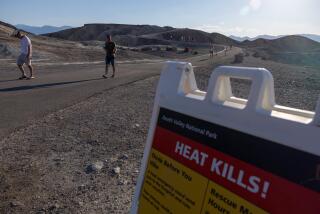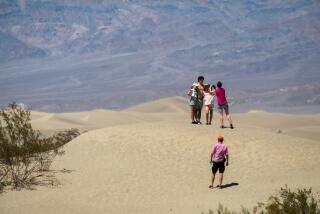Dearth of European Tourists Takes a Toll on Death Valley
DEATH VALLEY — The Europeans give, and the Europeans take away.
For years, French, Germans, Italians and a stream of continental compatriots flocked into the vast maw of this desert national park in the hottest months.
While American tourists steered clear in favor of more clement weather, tour buses and rental cars packed with European visitors streamed past the graceful sand dunes and inhospitable Badwater -- the Western Hemisphere’s lowest point -- and into the parking lots of the park’s resorts.
Europeans built a vibrant summer tourist industry in a place that seemed to epitomize their view of the extreme American West.
But today, a heavy chain and padlock hang from the doors of the Furnace Creek Inn. For the first time since the European tourist phenomenon compelled its owners to open for year-round business in 1997, the four-diamond resort is closed for the summer. Its massage rooms and ornate palm garden sit empty, its elegantly tiled, spring-fed swimming pool blankly mirroring the shimmering desert sky.
The blame lies with a poison cocktail of international travel jitters, sour economies and bitter feelings over the war in Iraq. The French, in particular, have canceled vacations in droves, tourists and hospitality industry experts say, fearing American hostility over their nation’s rejection of the Iraqi invasion.
“We read it in the newspaper: You don’t love us anymore. You say bad things about us,” said Giselle Foucaut, who marveled at the valley’s salt flats in 120-degree heat last week with her husband and granddaughter -- among the few French families visiting the park. Because of President Bush, she said, “and because of SARS in Canada
European and other international tourism is down across the country, denting national park attendance. But a spike in domestic car travel is making up the difference in many places where visitors don’t risk heat stroke with a midday picnic or find their contact lenses seared to their eyeballs.
Here in Death Valley, Europeans compose 90% to 95% of summer hotel visitors, so the drop in numbers is keenly felt.
“When we started, Furnace Creek Inn used to be closed in the summer because no one in their right mind would go to Death Valley with temperatures between 120 and 130 degrees,” said Michael Fitzpatrick, president of Los Angeles-based American Tours International, which books bus tours and driving itineraries for travelers from many countries. “But lo and behold, here came the Europeans.”
Bus tours have dropped by more than 30% in the last two years, Fitzpatrick said.
A weak euro had already dented the frenzied visitor pace in the summer of 2001. Then came the Sept. 11 terrorist attacks. But last summer “was worse than we planned on or expected it to be,” said Phil Dickinson, director of sales and marketing for the Furnace Creek Inn & Ranch Resort.
It was so dead in Death Valley that “you could roll a bowling ball down the middle of the visitor center,” said a park ranger, Paul Schmitt.
Then came this year’s war in Iraq and the scare over severe acute respiratory syndrome. Just as Americans have stuck close to home, so have Europeans, leaving travel arrangements for the last minute, if they make them at all.
“The unfortunate thing,” Dickinson said, is that travel industry representatives in Europe “aren’t able to give us a feel for whether it will get better.”
Rather than pay the high costs of food service and housekeeping and power the full-tilt air-conditioning needed to make the 66-room inn habitable, Xanterra Parks & Resorts has consolidated operations at the nearby 224-room Furnace Creek Ranch.
The Spanish-style historic inn closed May 22, and will not reopen until Oct. 10. Instead, the summer months will be spent on special projects -- modernizing the kitchen of the 1927 inn and trimming the towering date palms imported from Morocco about 70 years ago.
Signs are that Europeans are returning to the desert this year in greater numbers than last. While bus traffic had dwindled to one every few days last summer, this year some days have seen 10 pour through on the way from Las Vegas to San Francisco, said Terry Baldino, the park’s assistant chief of interpretation.
A late wildflower season and unusually lengthy spring have pushed visitor volume at the park 3% above this time last year. British tourists also seem to be coming in greater numbers. While temperatures have already topped 120 degrees, setting a record at the end of May, the peak summer season has not yet begun. And German travel seems to be picking up, Dickinson said.
But still, the landscape here is decidedly different with a smaller flock of European visitors. Just ask H. Vincent Fromm. As a development engineer for Ford Motor Co., Fromm has visited Death Valley 20 times and earned a place in its extreme summer subculture.
He is among the hordes of vehicle testers from all the major manufacturers who descend on the valley in summer to push car brakes, engines and other components on new models to their limits.
“In the summertime,” said Fromm, who performs cold-weather testing in Manitoba, Canada, and northern Michigan, “the only ones who are here are the Europeans and us test guys.”
But this summer “is terrible,” Fromm said as he powered down an oatmeal breakfast at 6:30 a.m. before a day of riding brakes down the valley’s steepest grade. “There aren’t as many cars coming through on the hill and I don’t even see the tours coming in.”
Nicole Becker, 30, of Cologne, Germany, was one of the undeterred. A marketing director for a German cruise line, she explained that many Germans are “saving their money” and vacationing in Spain or other closer locations.
Like many others here, Becker rented a car with her friend in Los Angeles and took a spin through the national parks of Utah and Arizona, then stopped in Las Vegas before heading for the real heat.
“It’s something you don’t have in Europe -- this hot wind,” she said, grinning. “It’s amazing.”
Sylvain Halbique, 34, a purchasing manager at a Paris trading company, has come to the United States many times. But many of his friends and co-workers -- particularly those who have never visited the U.S. -- were too uneasy to take a trip here.
“There are a lot of people in France who fear Americans will be aggressive toward Europeans because of the Iraqi war. They feel they will not be welcomed,” he said.
Halbique and his girlfriend, 22-year-old Sabrina Raffi, said they had met a French tour group at Lake Powell that had been booked for 40 people. Half of them had canceled.
The tourist drought is significant, but Dickinson, of the Furnace Creek Inn & Ranch, hopes it is temporary.
“The good news is we’re totally convinced that people in Europe are enamored with the American West,” he said. “Europeans love Death Valley. They love the vastness of the place. They love the extremes in temperature and the fact that the lowest point in the U.S. is here.... They’re going to be back.”
In the northern corner of the park, Tomas Trnovec and his wife, Viera Trnovcova, agreed.
The couple, from Bratislava, Slovakia, peered warily into the gaping Ubehebe Crater and snapped pictures, surrounded by nothing but the vast desert landscape.
They asked a reporter to send an e-mail message to their daughter back home in Slovakia.
“Tell her you met her parents in Death Valley,” Trnovcova said, laughing, “and they are still alive.”
More to Read
Sign up for The Wild
We’ll help you find the best places to hike, bike and run, as well as the perfect silent spots for meditation and yoga.
You may occasionally receive promotional content from the Los Angeles Times.







